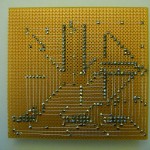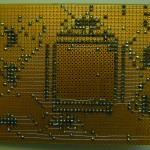Tag: circuit
Funny smoke
Just burned a 10K poti … I hate when that happens, which is somehow discouraging.
I was trying to replicate my own NE555 timer circuit (see wiki page) on a breadboard. This circuit will be the central piece of a signal/function generator I’m building.
For now it is simply an oscillator, but I will add a circuit which will convert the oscillator signal to different wave forms (sinus, triangle, saw tooth). Later on I’ll also add a micro controller to be able to have the device controlled using a serial interface or USB and give it a display and some keys.
I have already drawn a schematic and worked on a board layout, even though the thing is not totally finished. So, if you are interested, checkout the schematic and layout files from this directory in the labs repository (there is also a wiki page but its content is in a draft state).
lzoDSO – finished prototype board assembly
Yesterday I finished the assembly of the new front panel controller board, which evolved out of the old display carrier board). The circuit signal lines have already been tested (using continuity testing) and I’m not far away from having the prototype be contained inside its case.
In the new board I basically merged the core board with the display carrier board, since there was enough space available. A slight change I introduced is that I adjusted some pin mappings (namely we moved the LCD control lines from port B to D).
Schematic and Circuit Board
PDF files for schematic and board.
Now I’m updating the wiki page of the prototypes to get things in sync again.
lzoDSO – new prototype board
Actually I’m right in the middle of assembling a new circuit board I have created for the oscilloscope prototype. This “new” board is nothing more but the core controller board merged with the display carrier board into one.
You can find an image of the schematic and circuit board at the prototype branch directory inside the lzoDSO projects repository.








